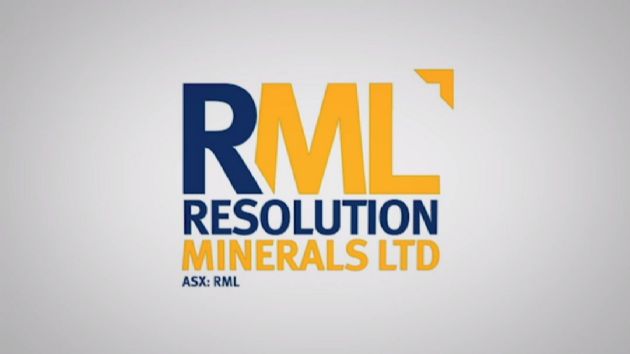Adelaide, Sep 1, 2021 AEST (ABN Newswire) - Resolution Minerals Ltd ( ASX:RML) (
ASX:RML) ( NC3:FRA) is pleased to announce that it has identified compelling drill targets on the Benmara Project in the Northern Territory. Drill targeting has resulted from initial exploration conducted by Resolution at the Benmara project following the recent grant of the tenure. A 2,500m RC drilling program is planned to commence in October and will take two (2) weeks to complete. Assay results will be reported to the market approximately four weeks later.
NC3:FRA) is pleased to announce that it has identified compelling drill targets on the Benmara Project in the Northern Territory. Drill targeting has resulted from initial exploration conducted by Resolution at the Benmara project following the recent grant of the tenure. A 2,500m RC drilling program is planned to commence in October and will take two (2) weeks to complete. Assay results will be reported to the market approximately four weeks later.
The targets have been derived from a VTEM Max geophysics survey flown by Resolution earlier this year (RML ASX Announcement 9/7/2021), with final processing of the geophysics completed today alongside historic data review. The conductors identified could indicate the presence of massive sulfides or the presence of rocks that could be excellent trap sites (reductive units) for base metal mineralisation.
The interpreted flat lying conductive sedimentary units at 60m to 120m depth lie beneath a blanket of black clay negating the use of surface geochemical techniques, and it's only through modern geophysics that targets like this are identified. The VTEM survey was flown to test both the margin of the Murphy Inlier with the South Nicolson Basin for sediment hosted base metal mineralisation and areas of the Murphy Inlier for other styles of base metal mineralisation. Further analysis of the age of rock within our project tenements confirm similarities to those present at Walford Creek ( ASX:AML) and the Century Mine (
ASX:AML) and the Century Mine ( ASX:NCZ). No historic drill holes have tested the VTEM derived priority drill targets.
ASX:NCZ). No historic drill holes have tested the VTEM derived priority drill targets.
Previous explorers had focussed on shallow uranium and diamond prospectivity with almost no assays testing for base metals or gold. Figure 3* indicates previous drill holes and target of exploration activities by commodity.
Benmara Prospectivity and Exploration Targeting
Resolution has assessed the Benmara Project for sediment hosted stratiform base metal mineralisation, using the Walford Creek Deposit as an analogy. The Company reviewed historic company data, considered new Geoscience Australia interpretation of the geology and the updated SEEBASE(TM) depthto-basement Model of the surrounding basin architecture.
Recently, the prospectivity was greatly enhanced by work undertaken by the "Exploring for the Future" initiative, which included contributions from Geoscience Australia (GA), University of Adelaide, NTGS and University of Melbourne (Carson, et al., 2020).
Geochronology published by Geoscience Australia in 2020, demonstrates the Benmara Group is older than previously thought. Importantly GA determined that the Benmara Group is Paleoproterozoic instead of Mesoproterozoic, and stratigraphically and temporally equivalent to the prospective Fickling Group (Walford Creek Deposit Cu-Pb-Zn-Ag-Co) and the McNamara Group (Century Mine Pb-Zn-Ag). i.e. the right age and type of rocks are present.
The Exploring for the Future initiative has established evidence supporting a regional shallow-marine hydrothermal circulatory system and potential for associated base metal mineral systems coincident with the Benmara Project. The hydrothermal system is similar in age to base metal mineralisation in the well-endowed Mount Isa Province.
During 2021 Resolution completed a VTEM Max(TM) geophysical survey over the central zone of the tenement, targeting the basin margin where prospective onlapping sediments from the South Nicholson abutted the Murphy Inlier. The proposed model is the Murphy Inlier and acts as a wall directing upwelling fluid flow carrying metalliferous fluids to flow up the Fish River Fault. These fluids then flow up and through the potentially reductive sediments close to surface. The shaley-reductive units can act as traps sites for base metals to precipitate, potentially forming deposits. Due to the often-pyritic nature of these reductive units, they are detectable by VTEM surveys as conductive rocks or massive sulfides. Benmara is prospective for this mineralisation model.
Resolution's findings are that many of the key ingredients present at the analogous Walford Creek Deposit are present at the Benmara Project:
1. VTEM conductors are positioned on the margin of the South Nicholson Basin where basin sediments onlap the Murphy Inlier coincident with the Fish River Fault
2. Benmara Group sediments including volcanic and reductive units are stratigraphically and temporally equivalent to the highly prospective Fickling and McNamara Groups
3. Historic drillhole DDHCJ59 located between the two drill targets, intersected laminated shales (potential host rock) at a depth of 55m is consistent with the modelled VTEM SEEBASE(TM) is a structurally enhanced depth-to-basement model that defines the 3D geometry of subsurface basin systems.
VTEM Max(TM) (Versatile Time-Domain Electromagnetic) induces a "primary" magnetic field into the earth, which produces eddy currents in any conductors this field passes through. These eddy currents produce a time-varying secondary magnetic field that the VTEM Max system can measure. The stronger the conductor, the slower the secondary-field decays, so a "late-time" response is a favourable outcome.
VTEM can directly detect massive sulfides and/or identify conductive formations and thus could also detect reductant carbonaceous or pyritic shales in certain conditions, which are an excellent trap site for copper or base metal mineralisation.
Benmara potentially analogous to the Walford Creek Deposit
The Walford Creek Deposit has the following characteristics (www.aeonmetals.com.au/walford-creek)
- Sediment hosted stratiform Cu-Co-Ag-Pb-Zn mineralisation style
- Metalliferous basement fluids travel upwards against the Fish River Fault (extends to Benmara Project) on the boundary of the Mt Les Formation and Peters Creek Volcanics (Equivalent to Crow Formation and Murphy Inlier - Jarrett et al AGES 2020)
- Peters Creek Volcanics "wall" forcing fluids upwards to contact overlying conductive shale units
- Deposit of 40.9 Mt @ 2.03% CuEq (including 50,300t of contained cobalt metal)
Base metal mineralisation at Walford Creek is predominantly hosted in pyritic sedimentary units and associated dolomite (Mt Les Siltstone), which abut the steeply dipping Fish River Fault Zone for a strike length of 10km. This same fault system extends west across the NT border onto Resolution Minerals' Benmara Project (Figure 3*).
The Mt Les Siltstone of the Fickling Group is stratigraphically and temporally equivalent to the Riversleigh Siltstone of the McNamara Group (both part of the Lawn Hill Platform), and the Crow Formation of the Benmara Group (South Nicholson Basin), which has been identified on Resolution Minerals' Benmara Project. All three formations contain reduced, organic rich shales which make excellent depositional sites for base metal mineralisation (i.e. trigger metal precipitation).
To view tables and figures, please visit:
https://abnnewswire.net/lnk/7OHBO6IM
About Resolution Minerals Ltd
 Resolution Minerals Ltd (ASX:RML) is a mineral exploration company engaged in the acquisition, exploration and development of precious and battery metals - such as antimony, gold, copper, and uranium.
Resolution Minerals Ltd (ASX:RML) is a mineral exploration company engaged in the acquisition, exploration and development of precious and battery metals - such as antimony, gold, copper, and uranium.
Resolution Minerals Ltd Listed on the ASX in 2017 and has a broad portfolio of assets, such as the Drake East Antimony-Gold Project in north-eastern NSW and George Project prospective for silica sand and uranium.



![abnnewswire.com]()
Related Companies
Social Media
Share this Article
 ASX:RML) (
ASX:RML) ( NC3:FRA) is pleased to announce that it has identified compelling drill targets on the Benmara Project in the Northern Territory. Drill targeting has resulted from initial exploration conducted by Resolution at the Benmara project following the recent grant of the tenure. A 2,500m RC drilling program is planned to commence in October and will take two (2) weeks to complete. Assay results will be reported to the market approximately four weeks later.
NC3:FRA) is pleased to announce that it has identified compelling drill targets on the Benmara Project in the Northern Territory. Drill targeting has resulted from initial exploration conducted by Resolution at the Benmara project following the recent grant of the tenure. A 2,500m RC drilling program is planned to commence in October and will take two (2) weeks to complete. Assay results will be reported to the market approximately four weeks later.  ASX:AML) and the Century Mine (
ASX:AML) and the Century Mine ( ASX:NCZ). No historic drill holes have tested the VTEM derived priority drill targets.
ASX:NCZ). No historic drill holes have tested the VTEM derived priority drill targets.  Resolution Minerals Ltd (ASX:RML) is a mineral exploration company engaged in the acquisition, exploration and development of precious and battery metals - such as antimony, gold, copper, and uranium.
Resolution Minerals Ltd (ASX:RML) is a mineral exploration company engaged in the acquisition, exploration and development of precious and battery metals - such as antimony, gold, copper, and uranium. 








